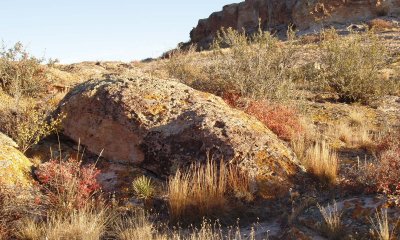
Rocky Foothills
Scenario model
Current ecosystem state
Select a state
Management practices/drivers
Select a transition or restoration pathway
- Transition T1A More details
- Restoration pathway R2A More details
-
No transition or restoration pathway between the selected states has been described
Target ecosystem state
Select a state
Description
The reference state has the greatest diversity and production of plants coupled with the least amount of bare ground. This state shows a mosaic of trees, shrubs, grasses, and forbs. Small clusters of pinyon and juniper are scattered throughout where deep and lateral root systems have found areas where moisture collects. Grasses with fibrous root systems such as western wheatgrass, needle and thread, Indian ricegrass, and blue grama take advantage of spring and summer rain to occupy areas where soil has collected between rocks. A diversity of forbs and shrubs use tap root systems to utilize moisture throughout the profile and into the crevices of the bedrock.
Resilience management
The reference state has the greatest resilience to disturbance. The diversity of species and root systems help maintain healthy ecosystem processes.
Submodel
Mechanism
As herbaceous diversity and cover have decreased due to grazing without adequate recovery periods along with over-utilization of preferred species, bare ground becomes available for expansion and germination of pinon and juniper seedlings. As trees slowly expand, deep and lateral root systems dominate available, seasonal moisture intake. The dropping of needle cast also discourages growth by herbaceous plants.
Model keys
Briefcase
Add ecological sites and Major Land Resource Areas to your briefcase by clicking on the briefcase (![]() ) icon wherever it occurs. Drag and drop items to reorder. Cookies are used to store briefcase items between browsing sessions. Because of this, the number of items that can be added to your briefcase is limited, and briefcase items added on one device and browser cannot be accessed from another device or browser. Users who do not wish to place cookies on their devices should not use the briefcase tool. Briefcase cookies serve no other purpose than described here and are deleted whenever browsing history is cleared.
) icon wherever it occurs. Drag and drop items to reorder. Cookies are used to store briefcase items between browsing sessions. Because of this, the number of items that can be added to your briefcase is limited, and briefcase items added on one device and browser cannot be accessed from another device or browser. Users who do not wish to place cookies on their devices should not use the briefcase tool. Briefcase cookies serve no other purpose than described here and are deleted whenever browsing history is cleared.
Ecological sites
Major Land Resource Areas
The Ecosystem Dynamics Interpretive Tool is an information system framework developed by the USDA-ARS Jornada Experimental Range, USDA Natural Resources Conservation Service, and New Mexico State University.
